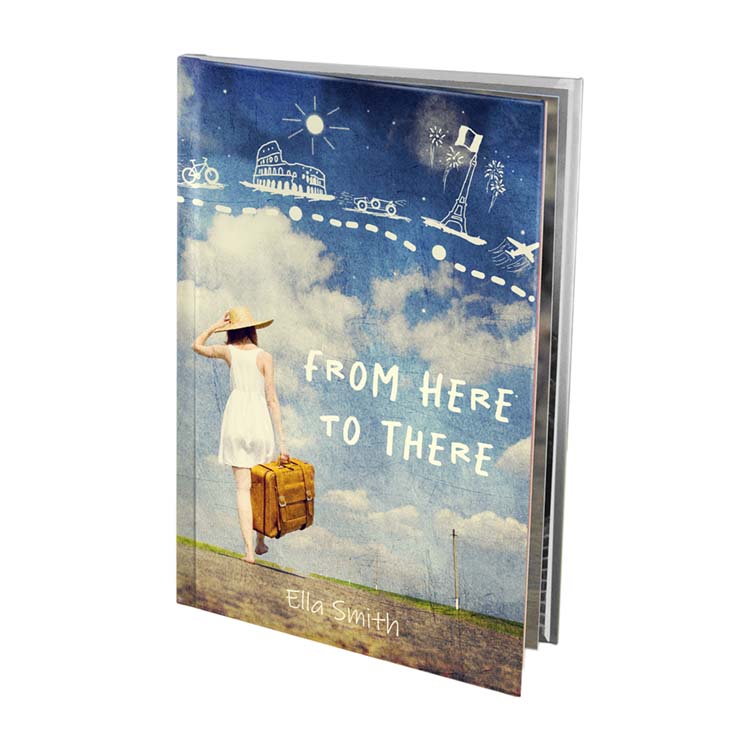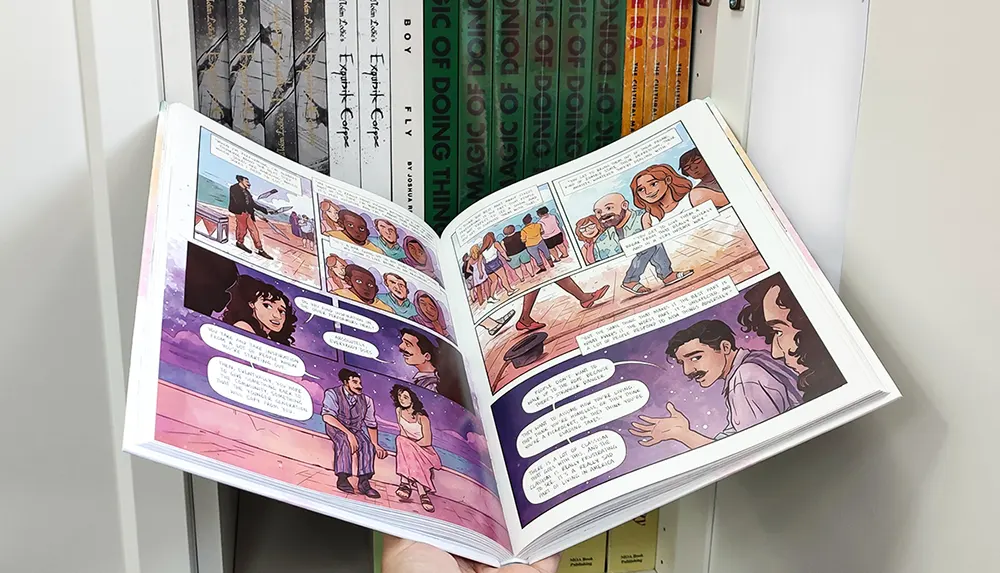A Comprehensive Overview to the Refine of Hardbound Books Printing
When you commence the journey of hardcover publication printing, comprehending the whole procedure is vital. As you browse via binding and top quality control, you'll locate that every decision affects the book's total charm.
Understanding the Hardcover Book Framework
When you discover the world of hardcover publications, you'll promptly observe that their structure is distinct and deliberate. The external case, commonly made of durable cardboard, offers durability and defense. You'll find a material or natural leather covering, which not just enhances looks however likewise includes in the publication's long life. Inside, the endpapers connect the cover to the text block, making certain a seamless interchange.
The text block itself includes several trademarks, or folded up sheets, sewn together for strength. You'll see that the spinal column is enhanced, permitting a smooth lay-flat reading experience - hardcover books. Additionally, the book's weight commonly shares a sense of quality and durability
Hardbound publications typically feature a dust coat, which acts as a marketing device while securing the cover. Understanding these aspects assists you value the workmanship behind hardcover books and their distinct allure in the literary globe.
Manuscript Prep Work and Editing And Enhancing
Obtaining your manuscript prepared for printing is necessary, and it begins with appropriate formatting guidelines. You'll need to comprehend the modifying procedure to improve your job and guarantee it reverberates with visitors. And also, grasping checking methods can assist you capture those annoying mistakes prior to your book goes to publish.

Manuscript Format Standards
Correct manuscript format is important for creating a professional-looking hardcover publication. Begin by choosing a common font style like Times New Roman or Arial in 12-point dimension. Use double-spacing throughout the record to boost readability. Establish your margins to 1 inch on all sides, providing your text space to take a breath. Number your web pages in the leading right corner, and include your chapter titles at the beginning of each new area. Use clear headings to indicate areas, and avoid extreme format like bold or italics unless required. Make certain to proofread your manuscript for consistency in design, guaranteeing that every little thing from spelling to spacing abides by your picked guidelines. Complying with these actions will certainly establish a solid foundation for your book.
Editing And Enhancing Refine Essentials
Editing your manuscript is an essential step that can transform it from a rough draft into a polished end product. Start by reading through your work critically, focusing on structure, circulation, and clarity. Look for inconsistencies in your narrative, personality development, or argumentation. It's helpful to take breaks between rounds of editing and enhancing to gain fresh viewpoints. Don't think twice to cut unnecessary web content or rephrase awkward sentences; this will certainly enhance readability. Consider seeking feedback from relied on peers or expert editors that can provide important insights. Remember, editing and enhancing isn't almost repairing errors; it has to do with improving your voice and guaranteeing your message resonates with viewers. Accept the process, and you'll see your manuscript sparkle.
Proofreading Strategies Summary
As soon as you've brightened your manuscript via modifying, the following step is to assure it's complimentary of mistakes that might sidetrack visitors. Beginning by relaxing after editing and enhancing; fresh eyes catch blunders better. Read your manuscript aloud-- this helps you listen to awkward wording and spot typos. Usage digital tools like spell checkers for preliminary scans, however don't depend exclusively on them. Think about publishing your manuscript; analysis theoretically can expose mistakes that screens miss out on. Concentrate on one kind of error each time, whether it's spelling or grammar, to avoid feeling bewildered. Enlist a trusted good friend or specialist proofreader to offer a fresh point of view. Their feedback can highlight concerns you may forget.
Designing the Book Cover and Interior
When you're designing your book cover and interior, you'll want to focus on necessary layout components that record your target market's interest. Selecting the ideal typography designs and meticulously picking shades and images can make all the distinction in communicating your book's theme. Let's explore just how these choices can boost your work and bring in readers.
Crucial Layout Aspects
Developing a captivating book cover and a well-designed inside is necessary for drawing in readers and boosting their experience. Select colors and photos that mirror your book's theme and state of mind.
A tidy, orderly style helps visitors browse effortlessly. Keep in mind, a natural design throughout your book cultivates a professional appearance that can greatly impact a viewers's decision to choose it up.
Picking Typography Styles
Typography plays a vital duty in both guide cover and interior decoration, forming just how readers view your material. When choosing typography styles, consider your publication's style and target market. A classic serif font style might function well for literary fiction, while a modern-day sans-serif could suit a contemporary book. Assurance readability; your message needs to be easy on the eyes, particularly for longer flows. Focus on font dimension and line spacing, as these elements affect overall flow. Mixing typefaces can add interest, but limit it to two or three to maintain coherence. Think about hierarchy-- use different styles for headings and body message to guide viewers effortlessly through your work. Your typography choices will significantly impact the reader's experience.
Shade and Imagery Selection
Choosing the right colors and images is essential for recording visitors' interest and conveying your publication's styles. Start by considering your category; dynamic colors could help a children's publication, while soft tones home suit an enigma book. hardcover books. Use images that reverberates with your content-- images, pictures, or abstract styles can enhance your message
When developing the cover, make particular the imagery doesn't overwhelm the title and writer's name; clarity is essential. This natural approach not only boosts your book's visual but likewise improves the reader's experience, making it a lot more remarkable.
Choosing the Right Paper and Products
When choosing paper and products for your hardbound book, it's important to ponder how they'll affect the general look and feel of your task. Beginning by choosing the best paper weight; heavier stock commonly shares high quality and durability, while lighter paper can create a more delicate touch. Think about the surface as well; shiny paper boosts pictures and shades, while matte can give an innovative, understated look.
Cloth, natural leather, or printed paper can set the tone for your book. In addition, assume regarding the binding products; making use of top notch glue warranties your publication lasts.
Inevitably, the selections you make right here show your vision, so take the time to example different products (hardcover books). Your choices will assist produce a publication that's not just aesthetically attractive yet functional and additionally long lasting
The Printing Process: Techniques and Technologies
A selection of printing techniques and technologies can bring your hardbound book to life, each offering unique benefits. Digital printing is a prominent selection for brief runs, allowing for fast turn-around and affordable solutions. When you need to publish smaller amounts without sacrificing top quality, it's ideal. On the various other hand, offset printing excels in generating big quantities, providing regular and top notch results. This method is ideal for considerable publications where shade precision and fine details issue.
Recognizing these strategies aids you make educated choices, ensuring your hardbound publication not just looks great but also meets your production requires effectively. Choose the right approach to elevate your publication's allure and influence.
Binding Approaches for Hardcover Books
Several binding techniques can transform your hardbound publication right into a long lasting and appealing Web Site product. One popular alternative holds true binding approach, where the pages are sewn with each other and after that affixed to a tight cover. This offers outstanding resilience and a professional appearance. One more method is the perfect binding, which makes use of glue to hold the web pages together, allowing for a streamlined spinal column but much less sturdiness compared to instance binding.
You may also take into consideration spiral binding, which enables your publication to lay flat, making it excellent for workbooks or manuals. Nonetheless, it doesn't use the same safety cover as instance binding. There's the saddle stitch approach, suitable for smaller sized publications, where sheets are folded and stapled together. Each binding approach has its benefits and fits different requirements, so think of your publication's purpose and audience when selecting the ideal option for your project.
Quality Assurance and Final Touches
After selecting the right binding technique for your hardbound publication, top quality control comes to be necessary to verify your end product fulfills your assumptions. Beginning by inspecting the printed pages for any mistakes or inconsistencies in color and design. You don't intend to miss any typos or misprints that could affect your readers' experience.
Next, examine the binding integrity. Verify the pages are securely attached which the back is tough. A well-bound publication not only looks expert however likewise feels durable in your hands.
Additionally, take note of the cover. Seek any kind of scuff marks or imbalances in the artwork. If you have actually selected special surfaces like embossing or foil marking, see to it they're applied consistently throughout all duplicates.
Lastly, carry out a complete assessment of the entire set before relocating to distribution. This means, you can verify that every book mirrors your high requirements.
Frequently Asked Questions
For how long Does the Hardcover Publication Printing Process Usually Take?

What Is the Minimum Order Quantity for Hardbound Books?
The minimum order quantity for hardcover books typically begin around 100 copies, yet it can differ based on the printer. You should contact your selected printing service for their details demands and prices.

Can I Publish Hardcover Books in Personalized Sizes?
Yes, you can print hardbound publications in custom dimensions. Numerous printing solutions use versatility with dimensions, allowing you to select a style that fits your project. Simply verify the specifications prior to placing your order.
Are There Eco-Friendly Options for Hardcover Book Printing?
Yes, you can discover green alternatives for hardbound publication printing. Numerous firms utilize lasting inks and recycled materials. Simply ask your printer concerning their green techniques to guarantee your project aligns with your ecological values.
What Are the Prices Related To Hardcover Publication Printing?
When considering hardcover book printing prices, you'll need to consider products, layout, and printing techniques. Added expenditures like delivery and binding can likewise impact your overall budget, so plan appropriately for your task.
When you begin the journey of hardcover book printing, comprehending the whole procedure is essential.A variety of printing techniques and innovations can bring your hardbound publication to life, each offering special benefits. Just how Lengthy Does the Hardbound Book Printing Process Normally Take?
The hardbound book printing process generally takes about 2 to 6 Bonuses weeks.Yes, you can discover green choices for hardcover publication printing.